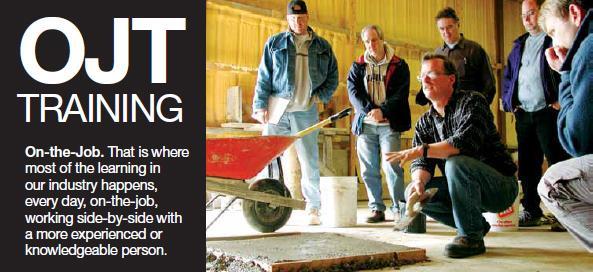September 5, 2013
 The On-the-job training (OJT) system was designed to help employers in the landscape horticulture sector to train employees in a consistent and effective way. Offered as a train the trainer workshop the method is design to focus on how most people learn - On-the-Job! They are simple in design, practical to use and provides employers with a safe and standardized approach to training. By improving how we train we increase the quality, speed, and efficiency of your efforts. OJT workshops are offered across Canada, please contact your provincial association for a schedule or to express interest. Sessions occur over 1.5 days of total training time and introduce the most easy to use and effective methods for training. Many companies have bought in to the OJT way and are seeing the benefits. ON-THE-JOB TRAINING: A SUCCESS STORY
— Brian Clegg, Allweather Landscape, Toronto Watch a video on On-the-Job Training hereUpcoming OJT seminars Reference guides and DVDs are available here through the Canadian Agricultural Human Resources Council (CAHRC) On-the-job training: Teaching quality, speed and efficiency National program makes anyone a confident teacher BY SARAH WILLIS The old adage, Those who can, do, and those who can’t, teach, doesn’t hold up in the green industry. The fact is that all those who do, teach, and do so on the job nearly every day. However, just because someone has the skills and the knowledge to complete a task, doesn’t mean he knows how to pass knowledge on to a other person. Were this true, Wayne Gretzky would be the greatest hockey coach of all time. Because labour is the largest expense in most sectors of the green industry, making sure workers are taught to perform work correctly and efficiently directly impacts a company’s bottom line. With this in mind, the Canadian Nursery Landscape Association (CNLA) worked with the Canadian Agriculture Human Resources Council (CAHRC) to develop a method to teach people how to teach. CNLA is pleased to offer all members a two-day workshop that focuses on teaching people how others learn, as well as the best methods of improving skills of trainers. Coined On the Job Training (OJT), the program uses a method originally devised to train factory workers during WW II. The wartime program was called Training Within Industry (TWI), created to fill the critical production jobs vacated by soldiers. The new workers needed to get up to speed quickly and seamlessly, with no loss to quality or safety. After the war, Gen. MacArthur passed the training method on to the Japanese; Toyota still uses it to train one of the most productive workforces in the automotive industry. Joel Beatson, professional and business development manager with CNLA, explains that the association rolled out OJT Train the Trainer seminars in 2010, with the goal of setting up a network of master trainers able to offer this proven method for on-the-job instruction to owners and managers in every province. Keep it simple OJT is a simple four-step program. The first step is to prepare workers to learn. Find out what they already know. Beatson explains that almost everyone in the green industry is an adult learner, and brings a spectrum of life experience to the job. Putting workers at ease and positioning them to learn is fundamental to the success of OJT. Working side-by-side is a key factor in workers learning jobs correctly, says Beatson, who explains that working face-to-face leads to mirroring a task, and not necessarily getting it right. Step two is to present the operation and demonstrate what you are going to do, one step at a time. Here, the most important thing to remember is to include the whys as students watch you perform a task. If your worker can explain the reason he is doing each step, it’s locked in. For example, students need to understand the reason why interlocking pavers are dropped into place, not put on the screening base and dragged into place. The third step is to have workers try the jobs out. They should show you they can carry out the task, and at the same time, tell you what they are doing, and why. Here, Beatson says, the key is to correct mistakes as soon as they happen. Don’t let little things slide because you are busy; take an extra minute to fix them right away. Training ends when you are confident workers know the task. The final step is to follow up. Check back in later, and make sure the worker understood what you were teaching. Create a culture where employees are comfortable asking for help if they need it. With frequently performed tasks, the need for training will tail off. However, if a task is performed rarely, recognize that workers may need a bit more follow up. Live in the moment Beatson explains that giving a new worker too much explanation is a common error for many managers or foremen. He says best results come from training in the moment, for the task you are doing. For example, if mowing a flat lawn with no grade change in sight, don’t start explaining about all the variables and safety issues of mowing on a hill. Teach one task at a time — what workers need to know at that moment. This way, short training moments will happen throughout the day as a job progresses. OJT trainers recognize that workers can’t be in training 100 per cent of the time — they have to produce as well. The four-step OJT system should take about 10-15 minutes maximum to complete. Beatson notes that the personalities in the green industry tend to have an ‘it’ll be faster if I do it myself’ and ‘no one can do the job as well as me’ mentality. Recognize that it might take a bit longer to train a worker to do a job effectively, but that time will be paid back in spades. Real-life results Businesses adopting the OJT program have seen a 50-100 per cent improvement in training efficiency. Once they institute the four-step training program, they are not having to show workers how to do a job again, or redo work that was performed incorrectly. Jeff Foley of Para Space Landscaping in Burnaby, B.C., is a big fan of the OJT program. “It’s a great program. We were really already using most of the techniques, but OJT has systemized our training and ensures consistency on all our crews. We see our newer staff are a lot more confident when embarking on new tasks now, and feel it has had a positive effect on our company culture. We see results quite quickly now we’re using the OJT system.” Foley adds that, in regular follow ups his company conducts with new staff members, the new employees recognize and appreciate they are receiving training they haven’t been offered by previous employers. Foley has even extended the OJT system to his office team, who use it when training new staff, too. “The program is quite transferrable,” he says. Joey Wynberg of Signature Landscape in Moncton, N.B., says the OJT training system is so simple, “We all kind of do it already. Putting it all together into one package was helpful.” Signature Landscape trained its foremen on how to deliver the training system, and have seen it trickle down naturally to its crews. “OJT has helped with the whole culture of our company. Perhaps the biggest benefit is that it has helped our hiring process. We can now hire for attitude and fit, knowing our staff are able to train new hires effectively. OJT has improved the quality of our work.” In Alberta, Ron Francis of Alpha Better Landscaping in Calgary, sums up OJT with a favourite Chinese proverb. “If you tell me, I will listen. If show you me, I will see. But if you let me experience, I will learn.” Add follow up, and Francis says that’s OJT in a nutshell. Francis notes that previously staff would spend two hours training on the company’s systems in a classroom, and still not know it. Once the OJT philosophy was adopted, staff could understand and master the systems in a 30-minute hands-on OJT session, and be able to teach others as well. “It’s a lot easier to commit to a task if you know why you are doing it,” says Francis. “The OJT system requires a lot of work up front, but is well worth it in the end.” Francis, an experienced trainer adds, “I never realized how much difference it made to make the trainee feel comfortable. Once they are engaged, training is all that much easier and retention is outstanding.” Invest in success CNLA’s Beatson says that in theory, OJT will pay it forward, as eventually second- and third-generation workers who have been trained the OJT way will use it to teach co-workers. Many graduates of the program report enhanced work crew consistency with the OJT system. By working consistently, jobs can be costed more effectively, with savings achieved through reduced rework. OJT training sessions are offered through each provincial trade association. Larger companies can invite a trainer for an in-house training event. Participants receive a copy of the training standards, method outline, quick-review cards and training moment templates. To schedule an OJT training session, contact your provincial trade association. |
